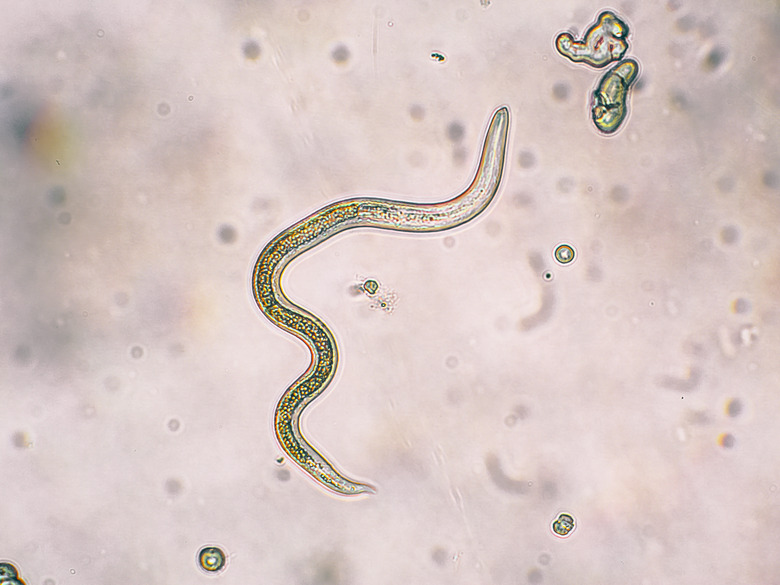What Does A Roundworm Look Like?
If you are squeamish, you might want to sit down. Few topics turn the stomach quite like discussions of parasites. However, for owners of cats, dogs and other small animals, understanding parasitic roundworm is crucial to maintaining the good health of those pets.
TL;DR (Too Long; Didn't Read)
Nematodes, or roundworm, appear symmetrical with tapered ends. Parasitic infection by roundworm is common in pets, especially puppies, since roundworm can pass from mother to offspring. Symptoms include malnourishment, vomiting and diarrhea. Treatment with deworming and preventative medications is simple.
What Is Roundworm?
What Is Roundworm?
Roundworm is the common name of nematodes, or worms from the Nematoda phylum. With approximately 20,000 named species and many more unnamed species, nematodes are some of the most common animals on the planet. These worms have diverse lives with some nematodes living independently in soil or aquatic environments and others living as parasites in other organisms.
Characteristics of Nematodes
Characteristics of Nematodes
In appearance, roundworms are symmetrical with ends that taper to a near-point. Nematodes vary widely in size. The smallest species are invisible to the naked eye while the largest is about 23 feet long and lives as a parasite inside whales. Nematodes have a membrane that covers the outside of the body called the external cuticle that periodically sheds or molts.
Parasitic nematodes that require animal hosts to survive live throughout the host's body, usually in the organs of the circulatory, digestive and respiratory systems. Common names for parasitic roundworm include hookworm, lungworm, pinworm, threadworm and whipworm. These parasites cause disease in their hosts, such as ascariasis, filariasis and trichinosis.
Worms in Dogs and Other Pets
Worms in Dogs and Other Pets
Parasitic roundworm is a common veterinary issue diagnosed by fecal exam and treated with deworming and preventative medications. Roundworm is so common in dogs that nearly all dogs have the parasite at some time, usually as puppies with immature immune systems. Nematodes frequently pass from mother to offspring before birth or via the mother's milk because roundworm larva remains inside the dog's body even after treatment. This encysted or inactive larva is dormant but activates when a dog becomes pregnant. For this reason, it is a good idea to deworm all puppies. Other means of infection include ingestion of roundworm eggs found in soil, plants or other animals.
The signs of worms in puppies and other animals are usually obvious, although some animals show no symptoms. Symptoms may include a malnourished or pot-bellied appearance, coughing, vomiting and diarrhea. Some unlucky pet owners may discover a particular disgusting sign of roundworm: the appearance of intact, spaghetti-like worms, which may be alive and wriggle, in the pet's stool or vomit.
While parasites are definitely unpleasant or even downright gross, nematodes are still important organisms. The broad range of roundworm species is valuable for scientific investigation.
Cite This Article
MLA
Mayer, Melissa. "What Does A Roundworm Look Like?" sciencing.com, https://www.sciencing.com/what-does-roundworm-look-like-4622439/. 22 November 2019.
APA
Mayer, Melissa. (2019, November 22). What Does A Roundworm Look Like?. sciencing.com. Retrieved from https://www.sciencing.com/what-does-roundworm-look-like-4622439/
Chicago
Mayer, Melissa. What Does A Roundworm Look Like? last modified March 24, 2022. https://www.sciencing.com/what-does-roundworm-look-like-4622439/
